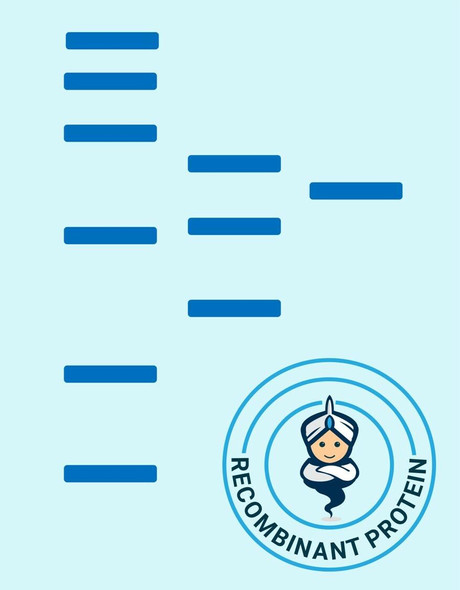Human PGRN Recombinant Protein (RPPB0852)
- SKU:
- RPPB0852
- Product type:
- Recombinant Protein
- Size:
- 10ug
- Species:
- Human
- Target:
- PGRN
- Synonyms:
- GRN
- PGRN
- granulin
- Acrogranin
- Source:
- HEK293 Cells
- Uniprot:
- P28799
Description
| Product Name: | Human PGRN Recombinant Protein |
| Product Code: | RPPB0852 |
| Size: | 10µg |
| Species: | Human |
| Target: | PGRN |
| Synonyms: | GRN, PGRN, granulin, Acrogranin, propithelin, PC cell derived growth Factor, GEP, GP88, PEPI, PCDGF. |
| Source: | HEK293 Cells |
| Physical Appearance: | Sterile Filtered clear solution. |
| Formulation: | The protein solution contains 1xPBS. |
| Stability: | Store at 4°C if entire vial will be used within 2-4 weeks. Store, frozen at -20°C for longer periods of time.For long term storage it is recommended to add a carrier protein (0.1% HSA or BSA). Avoid multiple freeze-thaw cycles. |
| Purity: | Greater than 95.0% as determined by SDS-PAGE. |
| Biological Activity: | Activates ERK phosphorylation in THP-1 and MCF10A cells and induces cell migration of THP-1 monocytic leukemia cells. |
A 88-kDa progranulin, also called proepithelin and PC cell-derived growth factor, is a single precursor protein of granulins which are a family of secreted, glycosylated peptides that are cleaved from a single precursor protein with 7.5 repeats of a highly conserved 12-cysteine granulin/epithelin motif. Granulins are a variety of active, 6 kDa peptides and named granulin A (epithelin 1), granulin B (epithelin 2), granulin C, etc. Both the peptides and intact progranulin protein regulate cell growth. However, different members of the granulin protein family may act as inhibitors, stimulators, or have dual actions on cell growth. Granulin family members are important in normal development, wound healing, and tumorigenesis.
Progranulin Human Recombinant fused to FLAG at C-terminus produced in HEK is a single, glycosylated, polypeptide chain containing 1-593 amino acids and having a molecular mass of 70kDa. The Progranulin is purified by standard chromatographic techniques.
| UniProt Protein Function: | GRN: Granulins have possible cytokine-like activity. They may play a role in inflammation, wound repair, and tissue remodeling. Defects in GRN are the cause of ubiquitin-positive frontotemporal dementia (UP-FTD); also known as tau- negative frontotemporal dementia linked to chromosome 17. Frontotemporal dementia (FTD) is the second most common cause of dementia in people under the age of 65 years. It is an autosomal dominant neurodegenerative disease. Defects in GRN are the cause of neuronal ceroid lipofuscinosis type 11 (CLN11). A form of neuronal ceroid lipofuscinosis characterized by rapidly progressive visual loss due to retinal dystrophy, seizures, cerebellar ataxia, and cerebellar atrophy. Cognitive decline may also occur. Neuronal ceroid lipofuscinoses are progressive neurodegenerative, lysosomal storage diseases characterized by intracellular accumulation of autofluorescent liposomal material. Belongs to the granulin family. 2 isoforms of the human protein are produced by alternative splicing. |
| UniProt Protein Details: | Protein type:Secreted; Secreted, signal peptide Chromosomal Location of Human Ortholog: 17q21.32 Cellular Component: intracellular membrane-bound organelle Molecular Function:growth factor activity; protein binding Disease: Ceroid Lipofuscinosis, Neuronal, 11; Frontotemporal Lobar Degeneration With Tdp43 Inclusions, Grn-related |
| NCBI Summary: | Granulins are a family of secreted, glycosylated peptides that are cleaved from a single precursor protein with 7.5 repeats of a highly conserved 12-cysteine granulin/epithelin motif. The 88 kDa precursor protein, progranulin, is also called proepithelin and PC cell-derived growth factor. Cleavage of the signal peptide produces mature granulin which can be further cleaved into a variety of active, 6 kDa peptides. These smaller cleavage products are named granulin A, granulin B, granulin C, etc. Epithelins 1 and 2 are synonymous with granulins A and B, respectively. Both the peptides and intact granulin protein regulate cell growth. However, different members of the granulin protein family may act as inhibitors, stimulators, or have dual actions on cell growth. Granulin family members are important in normal development, wound healing, and tumorigenesis. [provided by RefSeq, Jul 2008] |
| UniProt Code: | P28799 |
| NCBI GenInfo Identifier: | 77416865 |
| NCBI Gene ID: | 2896 |
| NCBI Accession: | P28799.2 |
| UniProt Secondary Accession: | P28799,P23781, P23782, P23783, P23784, Q53HQ8, Q53Y88 Q540U8, Q9BWE7, Q9H8S1, Q9UCH0, D3DX55, |
| UniProt Related Accession: | P28799 |
| Molecular Weight: | 44,132 Da |
| NCBI Full Name: | Granulins |
| NCBI Synonym Full Names: | granulin |
| NCBI Official Symbol: | GRN |
| NCBI Official Synonym Symbols: | GEP; GP88; PEPI; PGRN; CLN11; PCDGF |
| NCBI Protein Information: | granulins |
| UniProt Protein Name: | Granulins |
| UniProt Synonym Protein Names: | Proepithelin; PEPI |
| Protein Family: | Granulin |
| UniProt Gene Name: | GRN |
| UniProt Entry Name: | GRN_HUMAN |










